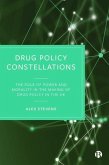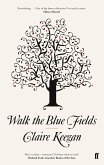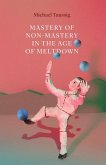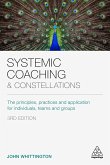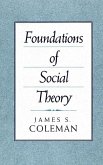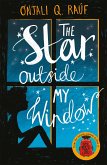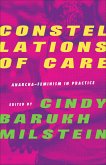Roel Smeets
Character Constellations
Representations of Social Groups in Present-Day Dutch Literary Fiction
Roel Smeets
Character Constellations
Representations of Social Groups in Present-Day Dutch Literary Fiction
- Broschiertes Buch
- Merkliste
- Auf die Merkliste
- Bewerten Bewerten
- Teilen
- Produkt teilen
- Produkterinnerung
- Produkterinnerung
Large-scale data analysis of cultural representation in Dutch literary fiction
Andere Kunden interessierten sich auch für
![Drug Policy Constellations Drug Policy Constellations]() Alex Stevens (Kent University)Drug Policy Constellations143,99 €
Alex Stevens (Kent University)Drug Policy Constellations143,99 €![Walk the Blue Fields Walk the Blue Fields]() Claire KeeganWalk the Blue Fields13,99 €
Claire KeeganWalk the Blue Fields13,99 €![Mastery of Non-Mastery in the Age of Meltdown Mastery of Non-Mastery in the Age of Meltdown]() Michael TaussigMastery of Non-Mastery in the Age of Meltdown24,99 €
Michael TaussigMastery of Non-Mastery in the Age of Meltdown24,99 €![Systemic Coaching and Constellations Systemic Coaching and Constellations]() John Whittington (Coach, facilitator, author)Systemic Coaching and Constellations52,99 €
John Whittington (Coach, facilitator, author)Systemic Coaching and Constellations52,99 €![Foundations of Social Theory Foundations of Social Theory]() James ColemanFoundations of Social Theory68,99 €
James ColemanFoundations of Social Theory68,99 €![The Star Outside my Window The Star Outside my Window]() Onjali Q. RaufThe Star Outside my Window8,99 €
Onjali Q. RaufThe Star Outside my Window8,99 €![Constellations of Care Constellations of Care]() Constellations of Care18,99 €
Constellations of Care18,99 €-
-
-
Large-scale data analysis of cultural representation in Dutch literary fiction
Hinweis: Dieser Artikel kann nur an eine deutsche Lieferadresse ausgeliefert werden.
Hinweis: Dieser Artikel kann nur an eine deutsche Lieferadresse ausgeliefert werden.
Produktdetails
- Produktdetails
- Verlag: Leuven University Press
- Seitenzahl: 252
- Erscheinungstermin: 15. November 2021
- Englisch
- Abmessung: 229mm x 155mm x 15mm
- Gewicht: 394g
- ISBN-13: 9789462702950
- ISBN-10: 9462702950
- Artikelnr.: 62228508
- Herstellerkennzeichnung
- Libri GmbH
- Europaallee 1
- 36244 Bad Hersfeld
- gpsr@libri.de
- Verlag: Leuven University Press
- Seitenzahl: 252
- Erscheinungstermin: 15. November 2021
- Englisch
- Abmessung: 229mm x 155mm x 15mm
- Gewicht: 394g
- ISBN-13: 9789462702950
- ISBN-10: 9462702950
- Artikelnr.: 62228508
- Herstellerkennzeichnung
- Libri GmbH
- Europaallee 1
- 36244 Bad Hersfeld
- gpsr@libri.de
Roel Smeets is assistant professor of modern literature and digital culture at Radboud University Nijmegen.
Chapter 1: Introduction 1.1 Introduction: Character Constellations
1.1.1 Example: Character Constellations in Joost Zwagerman's De buitenvrouw
(1994) and Robert Vuijsje's Alleen maar nette mensen (2008) 1.1.2
Delineation of the Study and Research Question 1.1.3 Character Studies
1.1.4 Characterization and Character Types 1.1.5 The One Versus the Many
1.2. Critique of Representation 1.2.1 Representation and Ideology 1.2.2
Critiques of Representation in Dutch Literature 1.3. Cultural Analytics
1.3.1 Debates on Distant versus Close Reading 1.3.2 Modeling in Cultural
Analytics 1.4 Methodological Background 1.4.1 Tools: Narratology and
Network Analysis 1.4.2 Corpus and Data 1.4.3 Previous Research on Corpus
and Dataset 1.5 Structure of the Book and Instruction for Reading
Chapter 2: Data 2.1 Introduction: Descriptive Statistics 2.2 Information on
the Authors 2.3 Demographic Metadata on the Characters 2.4 (In)Dependence
of Variables 2.5 Relational Information
2.6 Interpretation of Descriptive Statistics
Chapter 3: Centrality 3.1 Introduction: Narrative Cornerstones 3.2
Centrality in Network Theory 3.3 Centrality in Narratology 3.4 Method for
Extracting Character Networks 3.4.1 Characters as Nodes 3.4.2 Character
Relations as Edges 3.4.3 Automatic Extraction of Character Networks 3.5
Model I: Character Rankings 3.5.1 Results Multiple Regression Analysis
3.5.2 Close Reading: Centrality, Gender, and Descent in Özcan Akyol's Eus
(2012) 3.6 Conclusion to this Chapter
Chapter 4: Community 4.1 Introduction: Narrative Connections 4.2 Community
in Network Theory 4.2.1 Community Detection 4.2.2 Homophily 4.3 Community
in Narratology 4.3.1 Syntagmatic and Paradigmatic Collectives 4.3.2
Dialogic Interaction and Polyphony 4.4 Model I: Community Detection 4.4.1
Clauset-Newman-Moore and Girvan-Newman Algorithms 4.4.2 Kernighan-Lin
Bisection Algorithm 4.4.3 Close Reading: Communities in Philip Huff 's
Niemand in de stad (2012) 4.5 Model II: Homophily 4.5.1 Dyad Assortativity
4.5.2 Close Reading: Homophily in Mensje van Keulen's Liefde heeft geen
hersens (2012) 4.6 Conclusion to this Chapter
Chapter 5: Conflict 5.1 Introduction: Narrative Clashes 5.2 Conflict in
Network Theory 5.3 Conflict in Narratology 1 5.4 Model I: Hierarchies in
One-on-one Conflicts 5.4.1 Conflict Scores 5.4.2 Results of Multiple Linear
Regression 5.4.3 Close Reading: Class Conflicts between Two Characters in
Bart Koubaa's De Brooklynclub (2012) 5.5 Model II: Social Balance in
Triangular Conflicts 5.5.1 Automatic Modeling of Social Balance in
Enemy/Friend triads 5.5.2 Social Balance in Leon de Winter's VSV, of daden
van onbaatzuchtigheid 5.5.3 Social Imbalance in Tommy Wieringa's Dit zijn
de namen 5.6 Conclusion to this Chapter
Chapter 6: Conclusion 6.1 Findings of the Book 6.2 Public Debates on
Literary Representation 6.3 Future Research
Appendix A: Statistical tests Appendix B: Distribution of Relational Roles
Appendix C: Main and Interaction Effects Appendix D: Pearson Correlations
Notes References
1.1.1 Example: Character Constellations in Joost Zwagerman's De buitenvrouw
(1994) and Robert Vuijsje's Alleen maar nette mensen (2008) 1.1.2
Delineation of the Study and Research Question 1.1.3 Character Studies
1.1.4 Characterization and Character Types 1.1.5 The One Versus the Many
1.2. Critique of Representation 1.2.1 Representation and Ideology 1.2.2
Critiques of Representation in Dutch Literature 1.3. Cultural Analytics
1.3.1 Debates on Distant versus Close Reading 1.3.2 Modeling in Cultural
Analytics 1.4 Methodological Background 1.4.1 Tools: Narratology and
Network Analysis 1.4.2 Corpus and Data 1.4.3 Previous Research on Corpus
and Dataset 1.5 Structure of the Book and Instruction for Reading
Chapter 2: Data 2.1 Introduction: Descriptive Statistics 2.2 Information on
the Authors 2.3 Demographic Metadata on the Characters 2.4 (In)Dependence
of Variables 2.5 Relational Information
2.6 Interpretation of Descriptive Statistics
Chapter 3: Centrality 3.1 Introduction: Narrative Cornerstones 3.2
Centrality in Network Theory 3.3 Centrality in Narratology 3.4 Method for
Extracting Character Networks 3.4.1 Characters as Nodes 3.4.2 Character
Relations as Edges 3.4.3 Automatic Extraction of Character Networks 3.5
Model I: Character Rankings 3.5.1 Results Multiple Regression Analysis
3.5.2 Close Reading: Centrality, Gender, and Descent in Özcan Akyol's Eus
(2012) 3.6 Conclusion to this Chapter
Chapter 4: Community 4.1 Introduction: Narrative Connections 4.2 Community
in Network Theory 4.2.1 Community Detection 4.2.2 Homophily 4.3 Community
in Narratology 4.3.1 Syntagmatic and Paradigmatic Collectives 4.3.2
Dialogic Interaction and Polyphony 4.4 Model I: Community Detection 4.4.1
Clauset-Newman-Moore and Girvan-Newman Algorithms 4.4.2 Kernighan-Lin
Bisection Algorithm 4.4.3 Close Reading: Communities in Philip Huff 's
Niemand in de stad (2012) 4.5 Model II: Homophily 4.5.1 Dyad Assortativity
4.5.2 Close Reading: Homophily in Mensje van Keulen's Liefde heeft geen
hersens (2012) 4.6 Conclusion to this Chapter
Chapter 5: Conflict 5.1 Introduction: Narrative Clashes 5.2 Conflict in
Network Theory 5.3 Conflict in Narratology 1 5.4 Model I: Hierarchies in
One-on-one Conflicts 5.4.1 Conflict Scores 5.4.2 Results of Multiple Linear
Regression 5.4.3 Close Reading: Class Conflicts between Two Characters in
Bart Koubaa's De Brooklynclub (2012) 5.5 Model II: Social Balance in
Triangular Conflicts 5.5.1 Automatic Modeling of Social Balance in
Enemy/Friend triads 5.5.2 Social Balance in Leon de Winter's VSV, of daden
van onbaatzuchtigheid 5.5.3 Social Imbalance in Tommy Wieringa's Dit zijn
de namen 5.6 Conclusion to this Chapter
Chapter 6: Conclusion 6.1 Findings of the Book 6.2 Public Debates on
Literary Representation 6.3 Future Research
Appendix A: Statistical tests Appendix B: Distribution of Relational Roles
Appendix C: Main and Interaction Effects Appendix D: Pearson Correlations
Notes References
Chapter 1: Introduction 1.1 Introduction: Character Constellations
1.1.1 Example: Character Constellations in Joost Zwagerman's De buitenvrouw
(1994) and Robert Vuijsje's Alleen maar nette mensen (2008) 1.1.2
Delineation of the Study and Research Question 1.1.3 Character Studies
1.1.4 Characterization and Character Types 1.1.5 The One Versus the Many
1.2. Critique of Representation 1.2.1 Representation and Ideology 1.2.2
Critiques of Representation in Dutch Literature 1.3. Cultural Analytics
1.3.1 Debates on Distant versus Close Reading 1.3.2 Modeling in Cultural
Analytics 1.4 Methodological Background 1.4.1 Tools: Narratology and
Network Analysis 1.4.2 Corpus and Data 1.4.3 Previous Research on Corpus
and Dataset 1.5 Structure of the Book and Instruction for Reading
Chapter 2: Data 2.1 Introduction: Descriptive Statistics 2.2 Information on
the Authors 2.3 Demographic Metadata on the Characters 2.4 (In)Dependence
of Variables 2.5 Relational Information
2.6 Interpretation of Descriptive Statistics
Chapter 3: Centrality 3.1 Introduction: Narrative Cornerstones 3.2
Centrality in Network Theory 3.3 Centrality in Narratology 3.4 Method for
Extracting Character Networks 3.4.1 Characters as Nodes 3.4.2 Character
Relations as Edges 3.4.3 Automatic Extraction of Character Networks 3.5
Model I: Character Rankings 3.5.1 Results Multiple Regression Analysis
3.5.2 Close Reading: Centrality, Gender, and Descent in Özcan Akyol's Eus
(2012) 3.6 Conclusion to this Chapter
Chapter 4: Community 4.1 Introduction: Narrative Connections 4.2 Community
in Network Theory 4.2.1 Community Detection 4.2.2 Homophily 4.3 Community
in Narratology 4.3.1 Syntagmatic and Paradigmatic Collectives 4.3.2
Dialogic Interaction and Polyphony 4.4 Model I: Community Detection 4.4.1
Clauset-Newman-Moore and Girvan-Newman Algorithms 4.4.2 Kernighan-Lin
Bisection Algorithm 4.4.3 Close Reading: Communities in Philip Huff 's
Niemand in de stad (2012) 4.5 Model II: Homophily 4.5.1 Dyad Assortativity
4.5.2 Close Reading: Homophily in Mensje van Keulen's Liefde heeft geen
hersens (2012) 4.6 Conclusion to this Chapter
Chapter 5: Conflict 5.1 Introduction: Narrative Clashes 5.2 Conflict in
Network Theory 5.3 Conflict in Narratology 1 5.4 Model I: Hierarchies in
One-on-one Conflicts 5.4.1 Conflict Scores 5.4.2 Results of Multiple Linear
Regression 5.4.3 Close Reading: Class Conflicts between Two Characters in
Bart Koubaa's De Brooklynclub (2012) 5.5 Model II: Social Balance in
Triangular Conflicts 5.5.1 Automatic Modeling of Social Balance in
Enemy/Friend triads 5.5.2 Social Balance in Leon de Winter's VSV, of daden
van onbaatzuchtigheid 5.5.3 Social Imbalance in Tommy Wieringa's Dit zijn
de namen 5.6 Conclusion to this Chapter
Chapter 6: Conclusion 6.1 Findings of the Book 6.2 Public Debates on
Literary Representation 6.3 Future Research
Appendix A: Statistical tests Appendix B: Distribution of Relational Roles
Appendix C: Main and Interaction Effects Appendix D: Pearson Correlations
Notes References
1.1.1 Example: Character Constellations in Joost Zwagerman's De buitenvrouw
(1994) and Robert Vuijsje's Alleen maar nette mensen (2008) 1.1.2
Delineation of the Study and Research Question 1.1.3 Character Studies
1.1.4 Characterization and Character Types 1.1.5 The One Versus the Many
1.2. Critique of Representation 1.2.1 Representation and Ideology 1.2.2
Critiques of Representation in Dutch Literature 1.3. Cultural Analytics
1.3.1 Debates on Distant versus Close Reading 1.3.2 Modeling in Cultural
Analytics 1.4 Methodological Background 1.4.1 Tools: Narratology and
Network Analysis 1.4.2 Corpus and Data 1.4.3 Previous Research on Corpus
and Dataset 1.5 Structure of the Book and Instruction for Reading
Chapter 2: Data 2.1 Introduction: Descriptive Statistics 2.2 Information on
the Authors 2.3 Demographic Metadata on the Characters 2.4 (In)Dependence
of Variables 2.5 Relational Information
2.6 Interpretation of Descriptive Statistics
Chapter 3: Centrality 3.1 Introduction: Narrative Cornerstones 3.2
Centrality in Network Theory 3.3 Centrality in Narratology 3.4 Method for
Extracting Character Networks 3.4.1 Characters as Nodes 3.4.2 Character
Relations as Edges 3.4.3 Automatic Extraction of Character Networks 3.5
Model I: Character Rankings 3.5.1 Results Multiple Regression Analysis
3.5.2 Close Reading: Centrality, Gender, and Descent in Özcan Akyol's Eus
(2012) 3.6 Conclusion to this Chapter
Chapter 4: Community 4.1 Introduction: Narrative Connections 4.2 Community
in Network Theory 4.2.1 Community Detection 4.2.2 Homophily 4.3 Community
in Narratology 4.3.1 Syntagmatic and Paradigmatic Collectives 4.3.2
Dialogic Interaction and Polyphony 4.4 Model I: Community Detection 4.4.1
Clauset-Newman-Moore and Girvan-Newman Algorithms 4.4.2 Kernighan-Lin
Bisection Algorithm 4.4.3 Close Reading: Communities in Philip Huff 's
Niemand in de stad (2012) 4.5 Model II: Homophily 4.5.1 Dyad Assortativity
4.5.2 Close Reading: Homophily in Mensje van Keulen's Liefde heeft geen
hersens (2012) 4.6 Conclusion to this Chapter
Chapter 5: Conflict 5.1 Introduction: Narrative Clashes 5.2 Conflict in
Network Theory 5.3 Conflict in Narratology 1 5.4 Model I: Hierarchies in
One-on-one Conflicts 5.4.1 Conflict Scores 5.4.2 Results of Multiple Linear
Regression 5.4.3 Close Reading: Class Conflicts between Two Characters in
Bart Koubaa's De Brooklynclub (2012) 5.5 Model II: Social Balance in
Triangular Conflicts 5.5.1 Automatic Modeling of Social Balance in
Enemy/Friend triads 5.5.2 Social Balance in Leon de Winter's VSV, of daden
van onbaatzuchtigheid 5.5.3 Social Imbalance in Tommy Wieringa's Dit zijn
de namen 5.6 Conclusion to this Chapter
Chapter 6: Conclusion 6.1 Findings of the Book 6.2 Public Debates on
Literary Representation 6.3 Future Research
Appendix A: Statistical tests Appendix B: Distribution of Relational Roles
Appendix C: Main and Interaction Effects Appendix D: Pearson Correlations
Notes References


